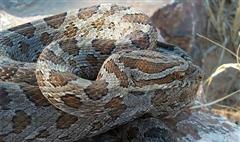Rat Snake - Emory's
Great Plains Rat Snake, Emory's Ratsnake, Emorys Ratsnake Scientific Name: Elaphe guttata emoryi
Sat, 19th April, 2025 - 5:25 am GMT
Sponsor Ads:

Alternative Name
Great Plains Rat Snake, Emory's Ratsnake, Emorys Ratsnake Scientific Name: Elaphe guttata emoryiBasic Info
Adult Emory's Rat Snakes average between 24 and 48 inches in length, thought they can reach over five feet in length. They appear in a variety of subspecies, with distinct colorations, both in the wild and in captivity. The most common Emory's Rat Snake is quite similar to the Cornsnake in appearance. They have gray skin with between 27 and 73 dorsal markings, and an equal amount of lateral markings. The markings vary greatly in shape and color, ranging between gray and dark brown or olive. Some individuals may be entirely lacking a pattern. The head has a spear point, similar to that of the Cornsnake. Markings on the head are often difficult to see. The intermontana subspecies of Emory's Rat Snake is characterized as being smaller with more dorsal blotches, generally oval. The intermontana variety can be found between Utah and western Colorado. The meahllmorum variety, found in South Texas and Mexico, generally have fewer dorsal blotches. It is very close in appearance to the regular Emory's Rat Snake. Chocolate Emory's Rat Snakes have a recessive gene that results in brown skin. The Chocolate Emory's Rat Snake is commonly bred in captivity, as are a variety of other colorations. One of these is the Amelanistic variety, which is white or very pale with yellow or yellow-orange blotches. The Striped Emory's Rat Snake is also available, on which the dorsal markings are fused into stripes.
Health
Emory's Rat Snakes should be provided with a hiding area, as well as a branch for resting and climbing. Good substrates for the enclosure include aspen shavings, outdoor carpeting, or Astroturf, or newspaper. The temperature in the enclosure should be about 85 degrees Fahrenheit at the warm end, 75 degrees at the cool end. The temperature should decrease to about 70 degrees at night. They should have access to fresh water at all times. The snake will use this water not only for drinking but also for bathing and defecating, so it may need to be cleaned. Breeding Breeding the Emory's Rat Snake is relatively easy. After the male and female mate, the female will lay a clutch of eggs in 6 to 8 weeks. The eggs should incubate at temperatures in the mid to upper 80s (Fahrenheit). Hatching will occur after 6 to 8 more weeks.Habitat
They are most common in sandy regions, with plenty of shelter in the form of rocky outcrops.Behavior
Emory's Rat Snake is a moderately sized snake found in North America. They are also known as the Great Plains Rat Snake. Usually non-aggressive, Emory's Rat Snake is common in captivity and is bred in a variety of colorations. Usually found on grassy plains, Emory's Rat Snake can also live in desert scrubland and tropical scrubland. Neither diurnal nor nocturnal, Emory's Rat Snake is active during the night and the day. They are usually found in regions of extreme temperatures and during very hot weather are active during the night, and in cooler weather are active during the daytime. In many of the regions in which they live, they are primarily nocturnal because daytime temperatures are very hot for much of the year. While not arboreal, Emory's Rat Snake is quite capable of climbing cliffs and they are excellent climbers.Origin
North AmericaHistory
Emory's Rat Snakes are found in the Southern United States and Mexico. They are often mistaken for Cornsnakes. The Cornsnake (Elaphe guttata emoryi) and the Emory's Rat Snake (Elaphe guttata emoryi) are both the same species but are different subspecies. Both Corn and Rat Snakes are found in the genus Elaphe, which means deerskin. Emory's Rat Snake is so named because they are quite adept at ridding areas of annoying rodents.Common Foods
They feed primarily on rodents, both in the wild and in captivity, though they also love birds and bats.Sponsor Ads:
"Forestall your opponent by seizing what he holds dear, and subtly contrive to time his arrival on the ground." -- Sun Tzu, The Art of War
Rat Snake - Emory's
Coded by: BGID® | ALL RIGHTS RESERVED Copyright © 2000-2025
Disclaimer | Privacy | Report Errors / Contact | Credits
















